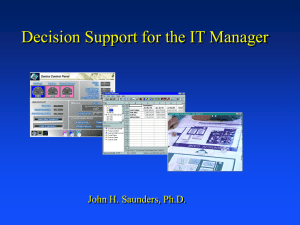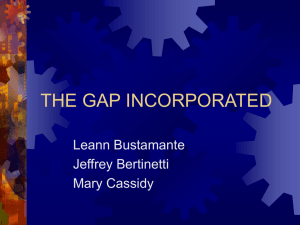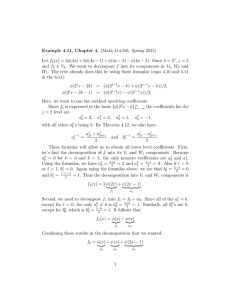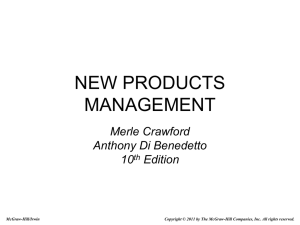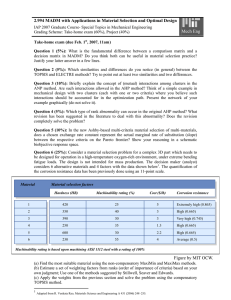Model Answer Final Examination Selected Problems in New York Civil Practice Spring 2003
advertisement
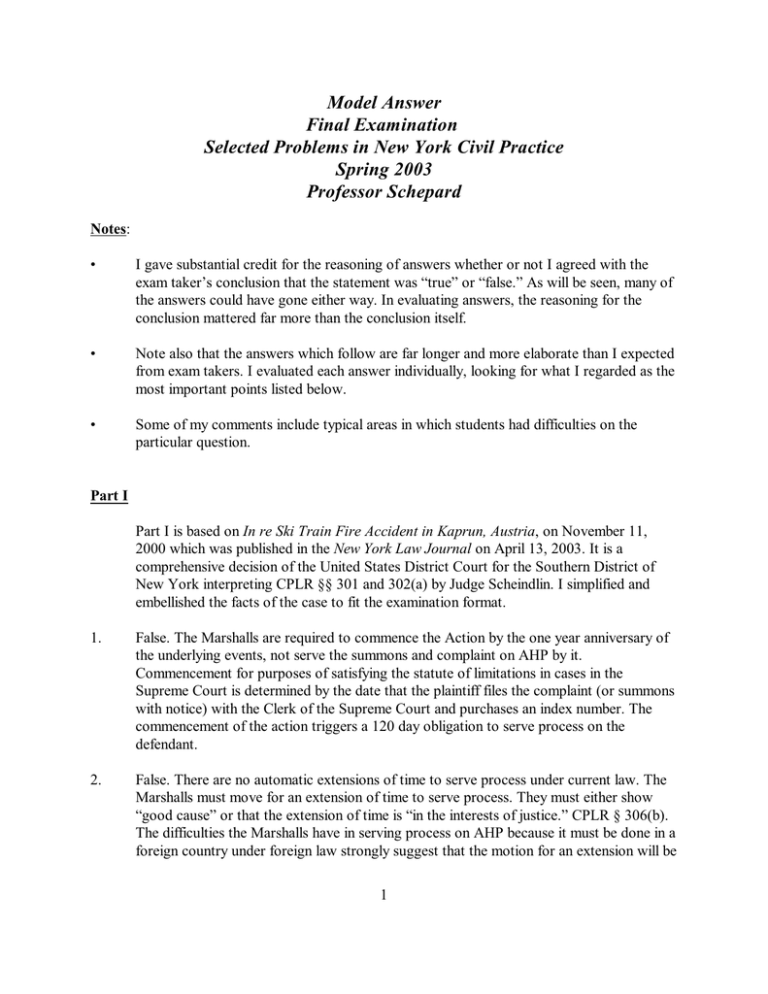
Model Answer Final Examination Selected Problems in New York Civil Practice Spring 2003 Professor Schepard Notes: • I gave substantial credit for the reasoning of answers whether or not I agreed with the exam taker’s conclusion that the statement was “true” or “false.” As will be seen, many of the answers could have gone either way. In evaluating answers, the reasoning for the conclusion mattered far more than the conclusion itself. • Note also that the answers which follow are far longer and more elaborate than I expected from exam takers. I evaluated each answer individually, looking for what I regarded as the most important points listed below. • Some of my comments include typical areas in which students had difficulties on the particular question. Part I Part I is based on In re Ski Train Fire Accident in Kaprun, Austria, on November 11, 2000 which was published in the New York Law Journal on April 13, 2003. It is a comprehensive decision of the United States District Court for the Southern District of New York interpreting CPLR §§ 301 and 302(a) by Judge Scheindlin. I simplified and embellished the facts of the case to fit the examination format. 1. False. The Marshalls are required to commence the Action by the one year anniversary of the underlying events, not serve the summons and complaint on AHP by it. Commencement for purposes of satisfying the statute of limitations in cases in the Supreme Court is determined by the date that the plaintiff files the complaint (or summons with notice) with the Clerk of the Supreme Court and purchases an index number. The commencement of the action triggers a 120 day obligation to serve process on the defendant. 2. False. There are no automatic extensions of time to serve process under current law. The Marshalls must move for an extension of time to serve process. They must either show “good cause” or that the extension of time is “in the interests of justice.” CPLR § 306(b). The difficulties the Marshalls have in serving process on AHP because it must be done in a foreign country under foreign law strongly suggest that the motion for an extension will be 1 granted for good cause. The Marshalls would be well-advised to make the motion to extend the time for service before the 120 day deadline expires. 3. False (probably, but a close question). AHP is required to try to work out its differences with the Marshalls before making a motion, as all motions affecting the bill of particulars must include an affirmation of a conference in good faith in an attempt to eliminate the need for the motion. Uniform Rule 202.7(a). An argument can be made that the Marshall’s bill does not tell AHP anything more than it knew already from the Complaint, in that the bill simply repeats the language of the allegations in the Complaint. If the primary purpose of the bill of particulars is to “amplify” the pleadings, the Marshalls bill fails. On the other hand, AHP has no right to demand “evidence” in a bill or to demand information requiring expert testimony. Identification of the particular defect in the power line that caused the injury may, in fact, be so complicated as to require expert testimony. Furthermore, the Marshalls assume an obligation to amend the bill after disclosure and thus tie themselves down to a theory of the case. They also have the right to amend the bill once as a matter of course. The critical question is when should a plaintiff be required to provide a defendant with details of its theory of why an accident occurs. In my view, it unreasonable for a defendant to demand that a plaintiff provide details at this early stage of the litigation about the nature of the defects when the accident resulted from the failure of a complex mechanical system like a train and power line. Plaintiff should be entitled to do some discovery before being pinned down to a theory of the case. Others may, of course, disagree as, likely, would several of the courts in the cases in the CB. Rulings on sufficiency of bills of particular tend to be sui generis. This problem points out why there is a strong case for abolishing the bill. 4. False. The events giving rise to the Action all occurred in Austria. Whatever cause and effect relationship there was between the lease transactions and AHP’s associated activity in New York and the accident that caused Eton’s death was broken by intervening negligence of someone in Austria. Eton’s death did not “arise from” any of AHP’s actions or transactions in New York, as required by CPLR § 302(a). The “arising from” requirement applies to all of the sections of the long-arm statute. AHP did not “transact any business” in the state that is linked to Eton’s death. Its tortious act occurred outside NY, not in it and Eton died in Austria, not New York. Neither CPLR § 302(a)(2) or (3) is applicable. Finally, the Complaint does not arise from any real property located in New York. The consent to jurisdiction clauses that AHP entered into in the lease transaction contracts are specific to claims arising from those transactions. They are not a consent to jurisdiction in New York for any unrelated claims against AHP that can be brought in a New York court. 5. (Double question). False. Long arm (specific) jurisdiction is precluded for the reasons set forth in response to Question 4. The Marshalls must thus look to general jurisdiction under CPLR § 301. General jurisdiction means that AHP can be sued for claims in New York that do not arise from its activities in New York. AHP is not incorporated in New 2 York and has not sought authorization from the Secretary of State to do business in New York. It is a classic “foreign corporation.” The best argument that the Marshall’s can make is that the multi-million dollar leasing New York based leasing transactions created AHP’s “corporate presence.” In the words of Judge Cardozo, the Marshalls have to argue that AHP’s activities in New York are so pervasive that it is in New York “not occasionally or casually, but with a fair measure of permanence and continuity.” AHP does not have an office in New York or any employees in New York. What it did was finance complex business expansion transactions using New York as a base. Here, New York’s relatively conservative jurisdictional philosophy intervenes. Many potential corporate defendants use New York financial markets to raise financing. Holding that such corporations are “present” in New York because they raise money in New York would discourage them from seeking capital here, to the detriment of New York’s economy. Such a holding would also make virtually every large corporation in the world subject to general jurisdiction in New York since virtually all of them raise capital in New York. Courts thus generally deem corporate financing transactions, even large and repeated ones like the lease transactions, as “limited and sporadic” and hold they do not indicate that a corporation is “present” in New York with a fair measure of permanence and continuity for purposes of general jurisdiction. 6. False. Again, we are talking about general, not specific jurisdiction. None of the Marshalls claims against AHP “arise from” AHP’s hiring New York counsel and advisors. Hiring New York counsel or a New York investment advisor to facilitate a financing transaction or transactions does not create corporate presence. If it did, corporations would be discouraged from hiring New York lawyers and investment advisors to the detriment of the economy. Furthermore, AHP’s New York lawyers and agents are independent contractors, not employees of AHP. They exercise independent professional judgment and presumably have other clients as well. While AHP’s retaining lawyers and financial advisors in New York 7. False. Having a website accessible to New Yorkers does not create corporate presence in New York. If it did, virtually every corporation that maintained an interactive website would be subject to general jurisdiction in New York. Solicitation of business in New York alone does not create general jurisdiction for similar reasons - it would discourage business activity in the State. New York follows the “solicitation plus” test for general jurisdiction. A foreign corporation needs a more permanent connection to be present here. No money changes hands between a New Yorker and AHP because of the web site, nor are any contracts entered into because of its existence. 8. False (probably). Virtually all of AHP’s New York business activities are incidental to the leasing transactions. Such complex financial transactions inevitably require AHP to have somewhat extensive administrative and managerial contacts with New York. Yet, these contacts are all related to AHP’s attempts to raise capital in the New York financial market, activity that New York courts do not want to discourage by subjecting AHP and 3 other corporations who use New York’s financial markets to general jurisdiction. Thus, the aggregate of AHP’s activities probably does not rise to presence in New York with a fair measure of permanence and continuity. On the other hand, AHP has a long standing and financially lucrative relationship with New York. Furthermore, AHP’s lease transaction contracts have a forum selection clause which indicates that AHP is willing to litigate in New York for some purposes, but not all. Overall, a close question, with the balance weighing in my mind against general jurisdiction over AHP. 9. False. As indicated earlier, there is no basis for either long arm or general jurisdiction (probably) over AHP in the Action. Acquiring jurisdiction over property in New York through attachment is, however, alive and well in New York under the Banco case (CB 99) to fill in gaps in the long arm statute. Shaffer, however, subjects attachment jurisdiction to minimum contacts scrutiny. The Millers will have to establish minimum contacts between the bank accounts in New York and Eton’s death in Austria as alleged in the Action. This is the same “arising from” problem that precludes New York long-arm jurisdiction. New York courts want foreign investors to put money in New York banks without incurring the risk that the accounts will be attached in an action here. There is no direct logical relationship between AHP’s bank accounts in New York and Eton’s death in Austria. The bank accounts were simply used to facilitate financing transaction for AHP in the New York financial markets. They did not have any known relationship with the ski train accident that claimed Etan Marshall’s life. It is unlikely, therefore, that there are sufficient minimum contacts to satisfy due process as there is no substantial nexus between New York, where the attached property is, the claims in the Action and the property located in New York, the bank accounts. 10. False (but close). There are two problems here: can the lawyer submit an affidavit and is the discussion of the need for the CEO’s deposition a legal argument appropriate for a memorandum of law rather than an affidavit. A lawyer is not absolutely precluded from filing affidavits or affirmations in support of a client’s motion. The affidavit that the lawyer files in support of this motion does not go to the merits of the underlying dispute (was AHP negligent) that will be argued at trial. Rather, it is on procedural matters (does the court have personal jurisdiction over the defendant and will a deposition help the court make that determination) that are separate from which party should win if the case goes to trial. If the lawyer files an affidavit that does go to the merits the lawyer would be a witness and would bring his or her personal credibility into question. The lawyer would then be disqualified from representing the client. The lawyer, however, is precluded from making statements in an affidavit that are not based on personal knowledge, as the standard for what can be included in an affidavit are the same as what is admissible in court. The lawyer probably has personal knowledge of why the deposition is important to the court’s determination of the motion to dismiss. The problem is, however, that his personal knowledge on this subject is a legal argument that should not be made in affidavit form but in a memorandum of law. 4 11. False (probably). The court has the authority to order the deposition of AHP’s CEO on the theory that the court has “jurisdiction to determine jurisdiction.” It can, but does not have to, exercise its discretion to delay determination of the motion pending the information from the deposition. The question is whether, however, it should order the deposition. So far, the Marshalls have not put forth any legally sufficient theory to establish personal jurisdiction over AHP in New York. It is not at all clear how AHP’s participation in a consortium with a United States company to purchase an Italian company has anything to do specifically with New York. Contacts in general with the United States are not relevant to the determination whether a corporation is present in New York for purposes of general jurisdiction. The Marshalls will have to make a stronger showing to justify delaying the court’s determination of the motion to dismiss to take this deposition. 12. False. A party’s obligation to serve a notice of appeal within thirty days is triggered by service of notice of entry of an order, not the entry of the order itself. The facts do not provide any indication of whether and when notice of entry of the Order was served. The CPLR does not specify any time limit for service of notice of entry. Either the winning or the losing side can serve notice of entry to start the time for serving a notice of appeal running. 13. True. The Order denies a motion to take a deposition in connection with a pending motion to dismiss the Complaint.. It is thus an intermediate (interlocutory) order because it does not finally determine the action (who wins and who loses – final judgment is not entered as a result of the Order). There is still a case to try and a dispositive motion (whether to dismiss the case for lack of jurisdiction) to be decided after the order is entered. In the federal system such intermediate orders are not appealable until after final judgment. In the New York State court system, however, under CPLR § 5701 (a) (2) (iv) or (v), the Marshalls have the right to appeal the Order to the Appellate Division, since it “involves some part of the merits” and “affects a substantial right”. 14. False. If the Appellate Division affirms the Order, the result is still an intermediate order. The case continues. There is no final judgment. Under CPLR § 5602 (b) 1. only the Appellate Division can give the Marshalls permission to appeal an intermediate order to the Court of Appeals. The Court of Appeals cannot grant permission to appeal an intermediate order to itself. The reason for this is to limit the number of applications to the Court of Appeals for leave to appeal intermediate orders. Many students did not understand that an intermediate order when affirmed by the Appellate Division remained an intermediate order. 15. (Double question) True (probably). This question is a lot like Problem A on page 119. If New York has personal jurisdiction over AHP, it is because of doctrines of corporate presence and general jurisdiction, not the State’s relationship to the underlying events alleged in the Complaint in the Action. The Marshalls presumably filed this case in New 5 York because they think they should get the procedural advantages New York law creates for them - jury trial, discovery and punitive damages. CPLR § 327 (a) specifically provides that the residence of the Marshalls or of Etan in New York “shall not preclude the court from staying or dismissing the action” under the doctrine of Forum non conveniens. AHP’s negligence occurred in Austria, the witness and evidence are likely to be in Austria. Austrian law is likely to govern the rights and liabilities of the parties, even in a New York court. It is easier for an Austrian court to apply New York law than it is for a New York court to do so. The extra procedural rights that New York law provides to the plaintiffs is not sufficient reason to deny a forum non conveniens motion. Plaintiffs who file a case in New York whose events are marginally connected to New York are entitled to justice that comports with basic standards of fairness, but not every procedural right that New York offers. Austria is a civilized Country with a developed justice system. It would be an insult to that Country to hold that because we did not agree with the absence of jury trials and disclosure in that Country’s legal system, all cases arising out of events in Austria filed in New York stay in New York. Such a holding would invite retaliation from Austria when cases against American defendants are filed in the courts of that Country. We want to encourage comity between nations, and keeping this case in New York would be a statement that New York courts do not have confidence in the quality of Austrian justice. On the other hand, AHP has indicated in the lease transactions that it does a great deal of business in New York and that it is willing to conduct some litigation in New York if it beneficial to its business. 16. (Double question) False (probably- a very close and difficult question). This question is a variation on Carnival Cruise Line (CB 54) and is designed to give you an opportunity to explain your views on a combined forum selection, arbitration and choice of law clause in a consumer transaction. I don’t care how you come out; it is your reasoning that counts. Some of the considerations I think important to the discussion follow. In Carnival Cruise Line, the Supreme Court held that Ms. Shute consented to a forum selection clause on the back of a ticket when she purchased the ticket from a travel agent. Here, however, Eton purchased the ticket in a foreign country at a railroad station. What were his options- to walk up the mountain? There is no evidence that he ever read or agreed to the clause. The clause was, however, written in a language he could understand if he choose to read it. The clause that the Supreme Court upheld in Carnival Cruise Line did not require the plaintiff to give up any valuable procedural rights such as jury trial and disclosure; it only required the plaintiff to litigate her claim in Florida, rather than her home state of Washington. Here, however, enforcement of the clause deprives the plaintiffs in a traditional tort action of a jury trial and disclosure as well as forces them to arbitrate in a foreign country. On the other hand, the clause is basically fair to the Marshalls; it allows them to pick one of three arbitrators and the arbitration follows the recognized rules of the American Arbitration Association. There are also questions of interpretation of the contract language. The arbitration clause is on the back of the railroad ticket. It might apply to a dispute between Eton and the railroad, but why should AHP, which has no contractual relationship of any kind with Eton get the benefit of the clause? Why should a 6 clause which binds Eton also be allowed to bind his “heirs and assigns” who did not purchase the ticket. Finally, an argument can be made that AHP waived its right to compel arbitration by participating in the Action. They filed a motion to dismiss and a demand for a bill of particulars before making the motion to compel arbitration. The court may deem this conduct to be inconsistent with a desire to arbitrate. Part II This question is based on the opinion of the New York Court of Appeals in Orans v. Novello, 2002 WL 3150747 (Court of Appeals Nov. 14, 2002). The Court split 4-3 on the question whether a physician’s assistant is a “lay person” within the meaning of the public health law. The opinion does not focus on the procedural aspects of bringing the question to the court via Article 78 and a declaratory judgment. 17. (Triple weight question). This is a complex and difficult question. Dr. Shelton is faced with the same kind of choice that the petitioner in Hampton Hospitals (CB 991) was faced with - should he initiate a declaratory judgment or Article 78 proceeding before the hearing begins or wait until the hearing is over and then challenge the composition of the hearing panel after the panel finds against him? Certainly, if he decides to seek relief before the hearing begins he must do so via order to show cause. He will either have to initiate a special proceeding under Article 78 via order to show cause or file a plenary action for declaratory relief and an injunction and move via order to show cause for a temporary restraining order. Dr. Shelton received notice of the composition of the hearing panel almost 120 days ago; the hearing is scheduled to begin in a few days. There is simply no time to initiate an Article 78 action via notice of petition if he wants relief before the scheduled hearing begins. The question remains, however, whether the court will intervene before the hearing commences or will wait until after the Committee, the Board, and the Commissioner render a final judgment of discipline against Dr. Shelton. One way for Dr. Shelton to encourage judicial intervention before a final decision of the Board is to frame his action as one for declaratory rather than coercive relief under CPLR § 3001. Dr. Shelton can argue that he is simply presenting a legal question in which a genuine dispute exists to the court for resolution, the definition of “lay person.” He is not asking the court to order the Board to do anything at this time but simply to construe a statute, a task in which the court have as much expertise as the agency. Should Dr. Shelton initiate a special proceeding under Article 78, he must try to identify the most appropriate writ to give him the relief before the hearing that he seeks. There are arguments in favor of and problems with all of them. One possibility is a mandamus to compel. The argument in favor of that writ is that the Commissioner has a non discretionary duty to 7 appoint a “lay person” to the Board, and a physician’s assistant is not a “lay person”. No demand has, however, yet been served on the Commissioner for such action, a prerequisite to a mandamus to compel. Furthermore, the Commissioner may argue that the court should not treat his decision as a separate administrative action, but rather a sub decision of an overall process. Finally, the Commissioner will argue that the court should defer to the Commissioner’s expertise in construing an ambiguous statute. Dr. Shelton might also seek a writ in the nature of prohibition. He can argue that the Commissioner, the Board and the Committee are proceeding in excess of its subject matter jurisdiction by holding a hearing in his case with a panel that includes a physicians’ assistant as its lay member. He will claim an important right is at stake - his medical license and thus his ability to practice his profession. A court may decide that the Committee is exercising a quasi judicial function in this case as it is hearing and evaluating the evidence of professional misconduct against him. Alternatively, the Commissioner will try to get the court to characterize his appointment of members of the Board as an executive, not a quasi judicial function. Another question in a prohibition analysis would be why the normal process of appeal within the agency is not sufficient to remedy the grievance. Dr. Shelton may argue that the question whether a physician’s assistant is a lay member is a question of law that the court should answer in which the Commissioner has no particular expertise. It would save Dr. Shelton and the Board significant time and aggravation to have the court answer the question in advance of the hearing. Otherwise, if Dr. Shelton is right, the Committee and the Board will have to hear and evaluate the evidence against him in a complex case and then start all over again with a properly composed Committee. The Commissioner can argue, however, that he should be given first crack at interpreting the statute before the Court intervenes. Dr. Shelton may, after all, be cleared of charges of professional misconduct and the issue might not reach the court on post-hearing review. The writ of mandamus to review requires that the court separate the Commissioner’s designation of the Board members as an administrative decision separate from the rest of the administrative process of deciding whether to discipline Dr. Shelton. Without such a characterization, there would not be the requisite finality of decision for judicial review. The writ of certiorari is premature. There has not yet been a “hearing” at which “evidence has been taken”. Dr. Shelton’s best chance for prehearing judicial intervention is probably to initiate an action for declaratory judgment and injunction and seek a temporary restraining order. If the court, however, perceives an action for declaratory judgment as a ruse to get around the restrictions of Article 78, however, it will simply apply those restrictions to the declaratory judgment action. Part III 8 18. (Triple weight question) I did not have any particular model answer in mind for question18 as it calls for an evaluation of a reform proposal for municipal tort cases in New York State and for reorganization of the tort system. Good papers addressed topics like: • Will this proposed reform make an incredibly complex trial court system even more complex. Why not unify the courts altogether? • If the Court of Claims takes on a larger number of cases, where will the judges come from to do it? Who will appoint them? Will that court become overburdened? • Should juries decide tort verdicts at all? Why not eliminate them altogether? Or are juries in civil tort cases a fundamental democratic institution? Are there other ways to limit tort recoveries (e.g. limitations on pain and suffering or punitive damages) that do not eliminate jury trial rights? • Why should state and municipal tort defendants (e.g. doctors in city hospitals) be protected from jury verdicts but similarly situated defendants in private settings (e.g doctors in private hospitals who commit the identical negligent acts) not be? Isn’t this discrimination against the poor who use municipal services by depriving them of a jury trial? • Does the jury trial guarantee of the New York State Constitution preclude this legislation? The answer to this question turns on a complex historical inquiry. Jury trial rights are guaranteed for those claims which were heard in the law courts before the merger of law and equity. State tort defendants, however, were immune from suit at common law. The waiver of jury trial was a condition of the state defendant’s waiver of sovereign immunity. The question for historical research is whether municipal defendants were also immune from suit at common law and whether the same waiver could extend to them. Another question is whether having provided jury trial for torts against municipal (not state) defendants the state is now precluded from arguing that the jury trial guarantee does not apply. • Would taking away municipal tort cases from the Supreme Court offend the provision of the New York State Constitution which guarantees the subject matter jurisdiction of the Supreme Court (discussed when we discussed the Kagen case (CB 143) at the beginning of the semester. Is this proposed legislation to take a class of cases away from the Supreme Court the kind of politically motivated exercise in contracting its subject matter jurisdiction that the constitutional guarantee is designed to protect against? Can this legislation be restructured so that the Court of Claims and the Supreme Court share subject matter jurisdiction in tort actions against municipalities and the Supreme Court develop a policy of transferring such cases to the Court of Claims. But would such a 9 transfer violate the constitutional guarantee of jury trial? So long as you identified some of the policy and constitutional issues involved in the proposal, I evaluated your paper well. I really do not care what side you took. 10


